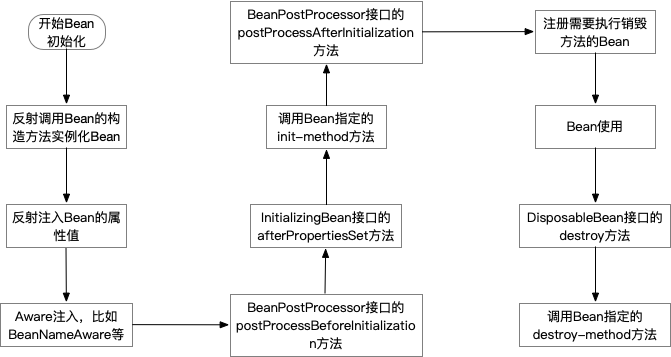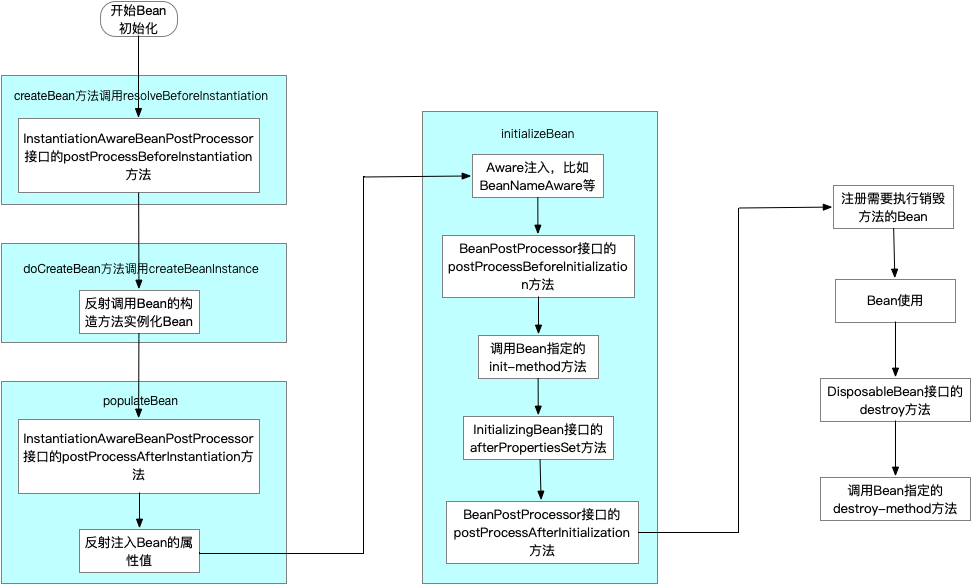上篇文章我们介绍了Spring Bean的初始化流程,在最后我们提到在通过populateBean方法调用后,调用了initializeBean方法,实现了一些列例如BeanNameAware、BeanPostProcessor等扩展接口的调用,本篇文章我们就来看一下Spring提供给开发者的一些扩展接口。
Spring框架运用了非常多的设计模式,从整体上看,它的设计严格遵循了OCP——开闭原则:
- 对修改关闭,外部无法修改Spring整个运作的流程
- 对扩展开放,可以通过继承、实现Spring提供的众多抽象类与接口来改变类加载的行为
本篇文章介绍的扩展接口就体现了对扩展开放的原则。
1. InitializingBean&DisposableBean
InitializingBean接口中提供了方法afterPropertiesSet(),DisposableBean接口中提供了方法destroy()。这两个接口功能类似,InitializingBean接口的afterPropertiesSet()方法用于Bean属性设置完毕(在invokeInitMethods方法中调用),做一些初始化操作。DisposableBean接口的destroy()方法用于Bean生命周期结束前(DefaultSingletonBeanRegistry的destroyBean方法调中调用)做一些收尾工作。
public interface InitializingBean {
void afterPropertiesSet() throws Exception;
}public interface DisposableBean {
void destroy() throws Exception;
}下面我们来看一个示例:
public class TestBean implements InitializingBean, DisposableBean {
private String testName;
public void setTestName(String testName) {
System.out.println("Call TestBean.setName()");
this.testName = testName;
}
public void destroy() throws Exception {
System.out.println("Call TestBean.destroy(), DisposableBean");
}
public void afterPropertiesSet() throws Exception {
System.out.println("Call TestBean.afterPropertiesSet(), InitializingBean");
}
public void initMethod() {
System.out.println("Call TestBean.initMethod(), init-method");
}
public void destroyMethod() {
System.out.println("Call TestBean.destroyMethod(), destroy-method");
}
}<?xml version="1.0" encoding="UTF-8"?>
<beans xmlns="http://www.springframework.org/schema/beans"
xmlns:xsi="http://www.w3.org/2001/XMLSchema-instance"
xsi:schemaLocation="http://www.springframework.org/schema/beans
http://www.springframework.org/schema/beans/spring-beans-4.1.xsd">
<bean id="testBean" class="com.zhuoli.service.spring.explore.extend.TestBean" init-method="initMethod" destroy-method="destroyMethod">
<property name="testName" value="testName"/>
</bean>
</beans>public class SpringExtendsTest {
public static void main(String[] args) {
AbstractApplicationContext applicationContext = new ClassPathXmlApplicationContext("classpath:spring-extends.xml");
TestBean testBean = (TestBean) applicationContext.getBean("testBean");
applicationContext.close();
}
}执行结果:
Call TestBean.setName()
Call TestBean.afterPropertiesSet(), InitializingBean
Call TestBean.initMethod(), init-method
Call TestBean.destroy(), DisposableBean
Call TestBean.destroyMethod(), destroy-method可以看到执行顺序为set方法、InitializingBean的afterPropertiesSet方法、bean init-method指定的初始化方法、DisposableBean的destroy方法、bean的destroy-method指定的销毁方法。
其实也好解释,通过上一篇文章我们知道setName方法是在populateBean方法中调用的,所以最先调用。InitializingBean的afterPropertiesSet方法是通过populateBean后面的方法initializeBean中调用的invokeInitMethods中调用的,并且调用在init-method之前,所以之后InitializingBean的afterPropertiesSet方法会被调用,接着才是init-method。
关于这几个接口,这里总结几点:
- InitializingBean接口、Disposable接口可以和Bean的属性init-method、destory-method配合使用,接口的优先级大于Bean的属性
- InitializingBean接口、Disposable接口方法的调用底层使用类型强转.方法名()进行直接方法调用,init-method、destory-method底层使用反射,前者和Spring耦合程度更高但效率高,后者解除了和Spring之间的耦合但是效率低(关于效率高低,这点不好讲,只是“理论之谈,反射也并不一定就比直接方法调用效率低很多。至于使用哪种方式,纯凭个人喜好)
- afterPropertiesSet()方法是在Bean的属性设置之后才会进行调用,某个Bean的afterPropertiesSet()方法执行完毕才会执行下一个Bean的afterPropertiesSet()方法,因此不建议在afterPropertiesSet()方法中写处理时间太长的方法
2. Aware接口
这里我们介绍BeanNameAware、ApplicationContextAware和BeanFactoryAware这三个Aware相关的接口。Aware的意思是”感知的”,顾名思义,这三个接口的意思也与“感知”相关。
- 实现BeanNameAware接口的Bean,可以在Bean加载的过程中获取该Bean的id
- 实现ApplicationContextAware接口的Bean,可以在Bean加载的过程中获取Spring的上下文ApplicationContext,从ApplicationContext中可以获取包括任意的Bean以及大量Spring容器内容和信息
- 实现BeanFactoryAware接口的Bean,可以在Bean加载的过程中获取加载该Bean的BeanFactory
下面来看个例子:
public class AwareBean implements InitializingBean, BeanNameAware, BeanFactoryAware, ApplicationContextAware {
private String beanName;
private ApplicationContext applicationContext;
private BeanFactory beanFactory;
@Override
public void afterPropertiesSet() throws Exception {
System.out.println("Call AwareBean.afterPropertiesSet(), InitializingBean");
}
public void setBeanName(String beanName) {
System.out.println("Call AwareBean.setBeanName(), beanName = " + beanName);
this.beanName = beanName;
}
public void setApplicationContext(ApplicationContext applicationContext) throws BeansException {
System.out.println("Call AwareBean.setApplicationContext(), applicationContext = " + applicationContext);
this.applicationContext = applicationContext;
}
public void setBeanFactory(BeanFactory beanFactory) throws BeansException {
System.out.println("Call AwareBean.setBeanFactory(), beanFactory = " + beanFactory);
this.beanFactory = beanFactory;
}
}<?xml version="1.0" encoding="UTF-8"?>
<beans xmlns="http://www.springframework.org/schema/beans"
xmlns:xsi="http://www.w3.org/2001/XMLSchema-instance"
xsi:schemaLocation="http://www.springframework.org/schema/beans
http://www.springframework.org/schema/beans/spring-beans-4.1.xsd">
<bean id="awareBean" class="com.zhuoli.service.spring.explore.aware.AwareBean" />
</beans>public class AwareBeanTest {
public static void main(String[] args) {
AbstractApplicationContext applicationContext = new ClassPathXmlApplicationContext("classpath:spring-aware.xml");
AwareBean awareBean = (AwareBean) applicationContext.getBean("awareBean");
applicationContext.close();
}
}执行结果:
Call AwareBean.setBeanName(), beanName = awareBean
Call AwareBean.setBeanFactory(), beanFactory = org.springframework.beans.factory.support.DefaultListableBeanFactory@7a187f14: defining beans [awareBean]; root of factory hierarchy
Call AwareBean.setApplicationContext(), applicationContext = org.springframework.context.support.ClassPathXmlApplicationContext@7e32c033, started on Thu Apr 16 09:01:20 CST 2020
Call AwareBean.afterPropertiesSet(), InitializingBean关于这三个接口,总结几点:
- 如果你的BeanName、ApplicationContext、BeanFactory有用,那么就自己定义一个变量将它们保存下来(如上面的成员变量beanName、applicationContext、beanFactory)。如果没用,那么只需要实现setXXX()方法,用一下Spring注入进来的参数即可
- 如果Bean同时还实现了InitializingBean,容器会保证BeanName、ApplicationContext和BeanFactory在调用afterPropertiesSet()方法前被注入,也就是说Aware接口的优先级大于InitializingBean接口
3. FactoryBean
传统的Spring容器加载一个Bean的整个过程,都是由Spring控制的,开发者除了设置Bean相关属性之外,是没有太多的自主权的。FactoryBean改变了这一点,开发者可以个性化地定制自己想要实例化出来的Bean,方法就是实现FactoryBean接口。下面来看个例子:
public interface Car {
public void driving();
}public class Bmw implements Car {
@Override
public void driving() {
System.out.println("Bmw driving");
}
}public class Benz implements Car {
@Override
public void driving() {
System.out.println("Benz driving");
}
}public class CarFactoryBean implements FactoryBean<Car> {
private String carName;
@Override
public boolean isSingleton() {
return true;
}
@Override
public Class<?> getObjectType() {
return Car.class;
}
@Override
public Car getObject() throws Exception {
if (carName.equals("Bmw")) {
return new Bmw();
} else if (carName.equals("Benz")) {
return new Benz();
} else {
return null;
}
}
public void setCarName(String carName) {
this.carName = carName;
}
}<?xml version="1.0" encoding="UTF-8"?>
<beans xmlns="http://www.springframework.org/schema/beans"
xmlns:xsi="http://www.w3.org/2001/XMLSchema-instance"
xsi:schemaLocation="http://www.springframework.org/schema/beans
http://www.springframework.org/schema/beans/spring-beans-4.1.xsd">
<bean id="car" class="com.zhuoli.service.spring.explore.factorybean.CarFactoryBean">
<property name="carName" value="Bmw"/>
</bean>
</beans>public class FactoryBeanTest {
public static void main(String[] args) {
AbstractApplicationContext applicationContext = new ClassPathXmlApplicationContext("classpath:spring-factory-bean.xml");
Car car = (Car) applicationContext.getBean("car");
car.driving();
}
}执行结果:
Bmw driving当我们把spring-factory-bean.xml配置文件中的value改为“Benz”时,同样执行上述代码,会得到执行结果:
Benz driving所以通过FactoryBean,最后得到的并不是FactoryBean本身,而是FactoryBean的泛型对象,这就是FactoryBean的作用。FactoryBean的几个方法:
- getObject():具体Bean的实例化过程
- getObjectType():接口返回的实例的Class对象
- isSingleton():返回该Bean是否为一个单例的Bean
我们回头看一下在面试中经常会问到的一个概念,BeanFactory和FactoryBean的关系?答案就非常明确了,这两者之间其实没有什么可比较的关系,只是命名比较接近。BeanFactory是Bean工厂,控制所有Bean的生成,实现了Spring IOC的基本功能。而FactoryBean是一种特殊的Bean,为IOC容器中的Bean提供了更加灵活的实现方式。
4. BeanPostProcessor
上面介绍的InitializingBean、DisposableBean、FactoryBean包括init-method和destory-method,都是针对某个Bean控制其初始化的操作,而似乎没有一种办法可以针对每个Bean的生成前后做一些逻辑操作,BeanPostProcessor可以帮我们做到这一点。BeanPostProcessor接口中定义了两个方法:
- postProcessBeforeInitialization:在Bean初始化前调用
- postProcessAfterInitialization:在Bean初始化后调用
下面看个简单的示例:
public class TestBean implements InitializingBean, DisposableBean {
private String testName;
public void setTestName(String testName) {
System.out.println("Call TestBean.setName()");
this.testName = testName;
}
public void destroy() throws Exception {
System.out.println("Call TestBean.destroy(), DisposableBean");
}
public void afterPropertiesSet() throws Exception {
System.out.println("Call TestBean.afterPropertiesSet(), InitializingBean");
}
public void initMethod() {
System.out.println("Call TestBean.initMethod(), init-method");
}
public void destroyMethod() {
System.out.println("Call TestBean.destroyMethod(), destroy-method");
}
}public class MyBeanPostProcessor implements BeanPostProcessor {
@Override
public Object postProcessBeforeInitialization(Object bean, String beanName) throws BeansException {
System.out.println("Call MyBeanPostProcessor.postProcessBeforeInitialization(), beanName = " + beanName);
return bean;
}
@Override
public Object postProcessAfterInitialization(Object bean, String beanName) throws BeansException {
System.out.println("Call MyBeanPostProcessor.postProcessAfterInitialization(), beanName = " + beanName);
return bean;
}
}<?xml version="1.0" encoding="UTF-8"?>
<beans xmlns="http://www.springframework.org/schema/beans"
xmlns:xsi="http://www.w3.org/2001/XMLSchema-instance"
xsi:schemaLocation="http://www.springframework.org/schema/beans
http://www.springframework.org/schema/beans/spring-beans-4.1.xsd">
<bean id="testBean0" class="com.zhuoli.service.spring.explore.beanpostprocessor.TestBean" init-method="initMethod" destroy-method="destroyMethod">
<property name="testName" value="testName0"/>
</bean>
<bean id="testBean1" class="com.zhuoli.service.spring.explore.beanpostprocessor.TestBean" init-method="initMethod" destroy-method="destroyMethod">
<property name="testName" value="testName1"/>
</bean>
<bean id="myBeanPostProcessor" class="com.zhuoli.service.spring.explore.beanpostprocessor.MyBeanPostProcessor" />
</beans>public class BeanPostProcessorTest {
public static void main(String[] args) {
AbstractApplicationContext applicationContext = new ClassPathXmlApplicationContext("classpath:spring-bean-post-processor.xml");
applicationContext.close();
}
}运行结果:
Call TestBean.setName()
Call TestBean.setBeanName(), BeanNameAware, beanName = testBean0
Call MyBeanPostProcessor.postProcessBeforeInitialization(), beanName = testBean0
Call TestBean.afterPropertiesSet(), InitializingBean
Call TestBean.initMethod(), init-method
Call MyBeanPostProcessor.postProcessAfterInitialization(), beanName = testBean0
Call TestBean.setName()
Call TestBean.setBeanName(), BeanNameAware, beanName = testBean1
Call MyBeanPostProcessor.postProcessBeforeInitialization(), beanName = testBean1
Call TestBean.afterPropertiesSet(), InitializingBean
Call TestBean.initMethod(), init-method
Call MyBeanPostProcessor.postProcessAfterInitialization(), beanName = testBean1
Call TestBean.destroy(), DisposableBean
Call TestBean.destroyMethod(), destroy-method
Call TestBean.destroy(), DisposableBean
Call TestBean.destroyMethod(), destroy-method可以看到在每个Bean填充属性(populateBean)之后,调用init-method之前,会执行Aware接口,BeanPostProcessor的postProcessBeforeInitialization方法和InitializingBean的afterPropertiesSet方法,并且优先级顺序依次是Aware接口、BeanPostProcessor和InitializingBean。BeanPostProcessor的postProcessAfterInitialization方法会在每个Bean调用init-method之后执行。所以我们大致可以得到下面这个Bean生命周期图:

另外需要注意的是,postProcessBeforeInitialization和postProcessAfterInitialization这两个方法是有返回值的,不要返回null,否则getBean的时候拿不到对象。
5. BeanFactoryPostProcessor
Spring允许在Bean创建之前,读取Bean的元属性,并根据自己的需求对元属性进行改变,比如将Bean的scope从singleton改变为prototype,最典型的应用应当是PropertySourcesPlaceholderConfigurer,替换xml文件中的占位符,替换为properties文件中相应的key对应的value等。这些工作都可以在BeanFactoryPostProcessor中完成。下面来看示例:
新增一个类MyBeanFactoryPostProcessor,实现BeanFactoryPostProcessor接口。
public class MyBeanFactoryPostProcessor implements BeanFactoryPostProcessor {
@Override
public void postProcessBeanFactory(ConfigurableListableBeanFactory configurableListableBeanFactory) throws BeansException {
System.out.println("Call TestBean.postProcessBeanFactory(), BeanFactoryPostProcessor");
}
}新增一个类MyBeanPostProcessor,实现BeanPostProcessor接口。
public class MyBeanPostProcessor implements BeanPostProcessor {
@Override
public Object postProcessBeforeInitialization(Object bean, String beanName) throws BeansException {
System.out.println("Call MyBeanPostProcessor.postProcessBeforeInitialization(), beanName = " + beanName);
return bean;
}
@Override
public Object postProcessAfterInitialization(Object bean, String beanName) throws BeansException {
System.out.println("Call MyBeanPostProcessor.postProcessAfterInitialization(), beanName = " + beanName);
return bean;
}
}新增一个测试Bean TestBean
public class TestBean implements BeanNameAware, InitializingBean, DisposableBean {
private String testName;
public void setTestName(String testName) {
System.out.println("Call TestBean.setName()");
this.testName = testName;
}
@Override
public void setBeanName(String s) {
System.out.println("Call TestBean.setBeanName(), BeanNameAware, beanName = " + s);
}
public void destroy() throws Exception {
System.out.println("Call TestBean.destroy(), DisposableBean");
}
public void afterPropertiesSet() throws Exception {
System.out.println("Call TestBean.afterPropertiesSet(), InitializingBean");
}
public void initMethod() {
System.out.println("Call TestBean.initMethod(), init-method");
}
public void destroyMethod() {
System.out.println("Call TestBean.destroyMethod(), destroy-method");
}
}新增xml配置
<?xml version="1.0" encoding="UTF-8"?>
<beans xmlns="http://www.springframework.org/schema/beans"
xmlns:xsi="http://www.w3.org/2001/XMLSchema-instance"
xsi:schemaLocation="http://www.springframework.org/schema/beans
http://www.springframework.org/schema/beans/spring-beans-4.1.xsd">
<bean id="testBean0" class="com.zhuoli.service.spring.explore.beanfartorypostprocessor.TestBean" init-method="initMethod" destroy-method="destroyMethod">
<property name="testName" value="testName0"/>
</bean>
<bean id="testBean1" class="com.zhuoli.service.spring.explore.beanfartorypostprocessor.TestBean" init-method="initMethod" destroy-method="destroyMethod">
<property name="testName" value="testName1"/>
</bean>
<bean id="myBeanPostProcessor" class="com.zhuoli.service.spring.explore.beanfartorypostprocessor.MyBeanPostProcessor" />
<bean id="myBeanFactoryPostProcessor" class="com.zhuoli.service.spring.explore.beanfartorypostprocessor.MyBeanFactoryPostProcessor" />
</beans>public class BeanFactoryPostProcessorTest {
public static void main(String[] args) {
AbstractApplicationContext applicationContext = new ClassPathXmlApplicationContext("classpath:spring-bean-factory-post-processor.xml");
applicationContext.close();
}
}运行结果:
Call TestBean.postProcessBeanFactory(), BeanFactoryPostProcessor
Call TestBean.setName()
Call TestBean.setBeanName(), BeanNameAware, beanName = testBean0
Call MyBeanPostProcessor.postProcessBeforeInitialization(), beanName = testBean0
Call TestBean.afterPropertiesSet(), InitializingBean
Call TestBean.initMethod(), init-method
Call MyBeanPostProcessor.postProcessAfterInitialization(), beanName = testBean0
Call TestBean.setName()
Call TestBean.setBeanName(), BeanNameAware, beanName = testBean1
Call MyBeanPostProcessor.postProcessBeforeInitialization(), beanName = testBean1
Call TestBean.afterPropertiesSet(), InitializingBean
Call TestBean.initMethod(), init-method
Call MyBeanPostProcessor.postProcessAfterInitialization(), beanName = testBean1
Call TestBean.destroy(), DisposableBean
Call TestBean.destroyMethod(), destroy-method
Call TestBean.destroy(), DisposableBean
Call TestBean.destroyMethod(), destroy-method跟上述4介绍BeanPostProcessor唯一不同的地方在于,在调用set方法设置Bean属性之前,调用了BeanFactoryPostProcessor的postProcessBeanFactory()方法,并且只调用了一次。所以可以看出:
- BeanFactoryPostProcessor的执行先于BeanPostProcessor
- BeanFactoryPostProcessor的postProcessBeanFactory()方法只会执行一次
结论也可以解释,BeanFactoryPostProcessor中定义的方法是在AbstractApplicationContext类中的refresh()方法中调用invokeBeanFactoryPostProcessors()方法实现的,而Bean的初始化是在之后调用finishBeanFactoryInitialization()方法实现的。所以BeanFactoryPostProcessor的执行先于BeanPostProcessor。
同时我们注意到postProcessBeanFactory方法的参数类型是ConfigurableListableBeanFactory,这就是为什么可以使用BeanFactoryPostProcessor来改变Bean的属性相对应起来了。ConfigurableListableBeanFactory功能非常丰富,它携带了每个Bean的基本信息。比如我们可以获取如下信息:
public class MyBeanFactoryPostProcessor implements BeanFactoryPostProcessor {
@Override
public void postProcessBeanFactory(ConfigurableListableBeanFactory configurableListableBeanFactory) throws BeansException {
System.out.println("Call TestBean.postProcessBeanFactory(), BeanFactoryPostProcessor");
BeanDefinition beanDefinition = configurableListableBeanFactory.getBeanDefinition("common0");
MutablePropertyValues beanProperty = beanDefinition.getPropertyValues();
System.out.println("scope before change:" + beanDefinition.getScope());
beanDefinition.setScope("singleton");
System.out.println("scope after change:" + beanDefinition.getScope());
System.out.println("beanProperty:" + beanProperty);
}
}6. InstantiationAwareBeanPostProcessor
上述介绍的几个Bean扩展接口都作用于Bean的初始化过程,其实Bean构建还包括一个过程——实例化。而这里要介绍的扩展接口InstantiationAwareBeanPostProcessor就是作用于这两个阶段,我们首先来看一下实例化和初始化的关系:
- 实例化:创建Bean的过程,即调用Bean的构造函数构造Bean实例
- 初始化:在Spring中的初始化可以理解为在调用Bean的setter方法设置属性后,调用init-method设置Bean的属性这一阶段
下面看个简单的示例,来认识一下InstantiationAwareBeanPostProcessor。
public class TestBean implements BeanNameAware, InitializingBean, DisposableBean {
private String testName;
public TestBean() {
System.out.println("Call TestBean's constructor");
}
public void setTestName(String testName) {
System.out.println("Call TestBean.setName()");
this.testName = testName;
}
@Override
public void setBeanName(String s) {
System.out.println("Call TestBean.setBeanName(), BeanNameAware, beanName = " + s);
}
public void destroy() throws Exception {
System.out.println("Call TestBean.destroy(), DisposableBean");
}
public void afterPropertiesSet() throws Exception {
System.out.println("Call TestBean.afterPropertiesSet(), InitializingBean");
}
public void initMethod() {
System.out.println("Call TestBean.initMethod(), init-method");
}
public void destroyMethod() {
System.out.println("Call TestBean.destroyMethod(), destroy-method");
}
}public class MyBeanPostProcessor implements BeanPostProcessor {
@Override
public Object postProcessBeforeInitialization(Object bean, String beanName) throws BeansException {
System.out.println("Call MyBeanPostProcessor.postProcessBeforeInitialization(), beanName = " + beanName);
return bean;
}
@Override
public Object postProcessAfterInitialization(Object bean, String beanName) throws BeansException {
System.out.println("Call MyBeanPostProcessor.postProcessAfterInitialization(), beanName = " + beanName);
return bean;
}
}public class MyInstantiationAwareBeanPostProcessor implements InstantiationAwareBeanPostProcessor {
public Object postProcessBeforeInstantiation(Class<?> bean, String beanName) throws BeansException {
System.out.println("Call MyInstantiationAwareBeanPostProcessor.postProcessBeforeInstantiation(), InstantiationAwareBeanPostProcessor");
return null;
}
public boolean postProcessAfterInstantiation(Object bean, String beanName) throws BeansException {
System.out.println("Call MyInstantiationAwareBeanPostProcessor.postProcessAfterInstantiation(), InstantiationAwareBeanPostProcessor");
return true;
}
public Object postProcessBeforeInitialization(Object bean, String beanName) throws BeansException {
System.out.println("Call MyInstantiationAwareBeanPostProcessor.postProcessBeforeInitialization(), InstantiationAwareBeanPostProcessor");
return bean;
}
public Object postProcessAfterInitialization(Object bean, String beanName) throws BeansException {
System.out.println("Call MyInstantiationAwareBeanPostProcessor.postProcessAfterInitialization(), InstantiationAwareBeanPostProcessor");
return bean;
}
}<?xml version="1.0" encoding="UTF-8"?>
<beans xmlns="http://www.springframework.org/schema/beans"
xmlns:xsi="http://www.w3.org/2001/XMLSchema-instance"
xsi:schemaLocation="http://www.springframework.org/schema/beans
http://www.springframework.org/schema/beans/spring-beans-4.1.xsd">
<bean id="testBean0" class="com.zhuoli.service.spring.explore.instantiationawarebeanpostprocessor.TestBean" init-method="initMethod" destroy-method="destroyMethod">
<property name="testName" value="testName"/>
</bean>
<bean id="myBeanPostProcessor" class="com.zhuoli.service.spring.explore.beanpostprocessor.MyBeanPostProcessor" />
<bean id="myInstantiationAwareBeanPostProcessor" class="com.zhuoli.service.spring.explore.instantiationawarebeanpostprocessor.MyInstantiationAwareBeanPostProcessor" />
</beans>public class InstantiationAwareBeanPostProcessorTest {
public static void main(String[] args) {
AbstractApplicationContext applicationContext = new ClassPathXmlApplicationContext("classpath:spring-instantiation-aware-bean-post-processor.xml");
applicationContext.close();
}
}运行结果:
Call MyInstantiationAwareBeanPostProcessor.postProcessBeforeInstantiation(), InstantiationAwareBeanPostProcessor
Call TestBean's constructor
Call MyInstantiationAwareBeanPostProcessor.postProcessAfterInstantiation(), InstantiationAwareBeanPostProcessor
Call TestBean.setName()
Call TestBean.setBeanName(), BeanNameAware, beanName = testBean0
Call MyBeanPostProcessor.postProcessBeforeInitialization(), beanName = testBean0
Call MyInstantiationAwareBeanPostProcessor.postProcessBeforeInitialization(), InstantiationAwareBeanPostProcessor
Call TestBean.afterPropertiesSet(), InitializingBean
Call TestBean.initMethod(), init-method
Call MyBeanPostProcessor.postProcessAfterInitialization(), beanName = testBean0
Call MyInstantiationAwareBeanPostProcessor.postProcessAfterInitialization(), InstantiationAwareBeanPostProcessor
Call TestBean.destroy(), DisposableBean
Call TestBean.destroyMethod(), destroy-method可以看出以下几点:
- postProcessBeforeInstantiation()方法会在调用构造方法实例化前调用
- postProcessAfterInstantiation()方法会在构造函数方法结束后调用
- InstantiationAwareBeanPostProcessor从BeanPostProcessor中继承的方法跟普通的BeanPostProcessor一样,会在init-method方法前后调用
通常来讲,我们不会直接实现InstantiationAwareBeanPostProcessor接口,而是会采用继承InstantiationAwareBeanPostProcessorAdapter这个抽象类的方式来使用。
加上InstantiationAwareBeanPostProcessor,我们再来看一下Bean的初始化流程:

参考链接:
1. Spring源码
 Zhuoli's Blog
Zhuoli's Blog